The new “mid-size” MB
Predecessor to the E-Class
February 1968
The new Mercedes-Benz models of the mid-size series 115 and 114 made a clean break with the “tailfin” era with its unitary body. The saloon was sporty, elegant, up to date, and above all a saloon in its own right. It was a demonstration of respectable flair and love of technical innovation. On top of that it reflected the awareness of its developers for the newly defined role of an intermediate model series.
Experts and public alike greeted the new intermediate class model from Mercedes-Benz enthusiastically when it was first presented to the media in January 1968. Internally all the Mercedes-Benz that appeared that year were given the abbreviation /8, but it was not long before the familiar “Stroke 8” designation was accorded only to models from the upper mid-range.
Snow, ice and the narrow mountain roads of the Madonie placed great demands on the suspension, but the Stroke 8 gave an excellent account of itself.
The “Stroke 8” was a major step forwards and set standards for subsequent generations of the midsize model series from Mercedes-Benz, today’s E-Class. Initially the model range comprised six saloons: the four-cylinder 200, 220, 200 D and 220 D models formed the 115 series. The two six-cylinder variants 230 and 250 were designated the 114 series and also, for differentiation purposes, a radiator with a large-mesh grille, of the sort fitted to the 280 S and 300 SEL 6.3 models since 1968.
As the top-of-the-range model the Mercedes-Benz 250 was distinguished from the other models by its double front bumper. From the beginning the demand for all models was high and soon resulted in long waiting times for delivery.
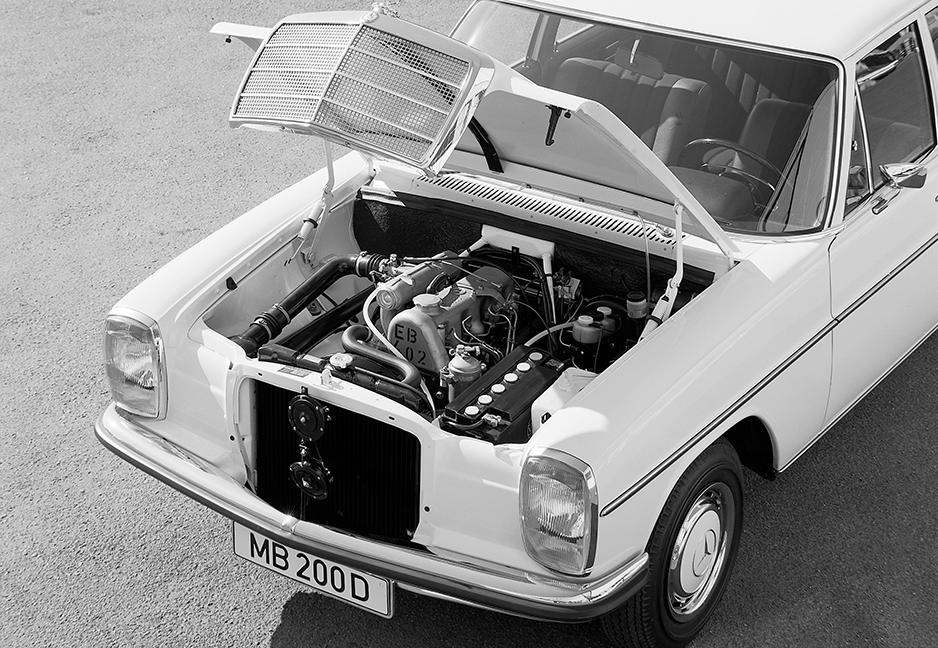
200D model reveals simplicity and clean lines of 115.
Development work since 1961
Designers and engineers began planning the new model series as early as 1961, the year in which the small tailfin had just reached the market. Project leader was Dr. Fritz Nallinger, Mercedes-Benz chief engineer, member of the Board of Management and Technical Director of Daimler-Benz AG. The technical structure of the forthcoming vehicle was determined by Karl Wilfert, Head of Body Development. This new intermediate class had to be an independent, successful model – that was clear to Development from the start. So the shared body was no longer an option. Stuttgart therefore strove to create a complement to the new luxury class 108/109 series for the year 1968.
As early as 1960 chief engineer Nallinger defined important benchmarks for the new vehicle. In direct comparison with the luxury class model the design was to be appreciably more compact than differences between the four and six-cylinder variants of the shared body allowed. In view of the smaller exterior dimensions, it would be important to ensure good space economy in the passenger compartment. The shape had to be timeless in its simple elegance.
In 1964 the designers’ models already showed the outlines of the future saloon. At that point, however, different designs of the front end were still under discussion. In analogy to the former distinction between four and six-cylinder variants, the versions of the new model family with smaller engines were to get a simpler front end with horizontally arranged rectangular headlamps. Finally, in early 1965, a decision was made to refrain from such differentiation, to which the two model series numbers 115 and 114 later still would testify. This was the year in which Professor Dr. Hans Scherenberg took over project management as chief engineer when Nallinger went into retirement.
Other body variants developed in addition to the saloon were a coupe, a long-wheelbase saloon and a station wagon. Whereas the sportier two-door and the long-wheelbase version of the saloon actually made it into production, the station wagon was ultimately barred from series production. On the other hand, the basic design of the rear end was later harmoniously transferred to the next model series, the 123, with only minor changes. In 1967 the production facilities for the new series were set up in Sindelfingen. Prior to the market launch proper, 1100 preproduction vehicles of the two series were produced there, limited initially to six models.
1968: Premiere for the new model series in Sindelfingen and Geneva
Mercedes-Benz unveiled the “Stroke 8” in a step-by-step approach. In December 1967 the series was presented to selected trade journalists in Sicily, then to further media representatives in January 1968. The general public got its first chance to assess the new saloon at the International Motor Show in Geneva that March.
The six models initially available met with the broad approval of the experts and the general public. The view expressed by the motor magazine auto motor and sport that Mercedes-Benz had dared to take a “stylistic swing to the left” can surely be put down mainly to the political situation of 1968. The “Stroke 8” deserved all the more praise for its clear, classic yet modern lines and its fresh, sporty appearance.
And yet the Mercedes-Benz character that determines automotive identity was fully retained in this model. The designers and engineers handled a task well that called for innovation and sensitivity. On the one hand, a clearer distinction now was made between the luxury and upper mid-size categories in the Mercedes-Benz product line-up. On the other hand, the family resemblance between the now independent models was still visible.

Taxi drivers´ darling: 1967 Mercedes-Benz 200 D in the classic black paintwork of pre-1970 German taxicabs.
Complete range: debut of the new series with six saloon models
The new Mercedes-Benz started out with six saloon models. The 200 and 220 were powered by the new four-cylinder M 115 carburettor engine, with 2-litre displacement (70 kW/95 hp) and 2.2-litre displacement (77 kW/105 hp) respectively. The 200 D and 220 D diesel variants also featured a new engine, the OM 615, in a 2-litre version with 40 kW (55 hp) and a 2.2-litre variant with 44 kW (60 hp) output.
The 2.3-litre in-line six-cylinder M 180 engine of the 230 model was already familiar from the predecessor model; it developed 88 kW (120 hp), as in the “tailfin”. New in the engine range was the 2.5-litre in-line six-cylinder M 114, which generated 96 kW (130 hp).
For the new petrol engines of both series, Mercedes-Benz relied on proven technology: the four-cylinder 200 and 220 models (M 115) were fitted with Stromberg horizontal carburettors, the six-cylinder of the 230 (M 180) and 250 (M 114) models with two Zenith downdraught compound carburettors. The 250 model was also equipped with an oil cooler.
The in-line carburettor engines had two overhead valves per cylinder and an overhead camshaft. The four-cylinder power plants (petrol and diesel) proved so reliable that the 123 series that followed in 1976 was initially equipped with the M 115 and OM 615 engines.

Classically modern, with double bumper: 1967 Mercedes-Benz 250 from the W 114 series.
Good handling owing to the diagonal swing axle
The outstanding constructional detail of the new model series was to be found under the boot: the “Stroke 8” models were fitted with a so-called diagonal swing axle, making this the first Mercedes-Benz production car to have a rear axle with semi-trailing arm. The diagonal swing axle was equipped among other things with auxiliary rubber springs and a torsion-bar stabiliser as standard. Compared with the predecessor models, the new axle afforded distinct improvements in handling characteristics without sacrificing ride comfort.
The improved handling quality was also acknowledged by international motor journalists, who were invited to the old Targa Florio course in Sicily for a preliminary road test in December 1967. Snow, ice and the narrow mountain roads of the Madonie placed great demands on the suspension, but the Stroke 8 gave an excellent account of itself.
And the cars were not lightweight by any means. Wheelbase and weight of the upper mid-range series of Mercedes-Benz had grown consistently bigger from the “Ponton” (2.65 metres and 1.22 metric tons) through the “tailfin” (2.70 metres and 1.28 metric tons) to the “Stroke 8” (2.75 metres and 1.36 metric tons). However, the overall length of the new model, 4.68 metres, was less than that of the 110 series.
The new proportion of overall body length to wheelbase was also visible in silhouette, with balanced proportions and clear lines. The additional weight was due mainly to measures designed to improve passive safety, which put into practice the ideas of Mercedes-Benz engineer Bela Barenyi, a pioneer in this field.
Coupe emphasizes sporting note
From October 1968 the model line-up of the new Mercedes-Benz was rounded off at the upper end by the 250 C and 250 CE coupes. That same winter the Stuttgart company also introduced a long-wheelbase saloon. In particular, the launch of the sporty two-door was a highly regarded premiere.
After all, this was the first time the brand with the three-pointed star had offered a coupe version as an exclusive variant in the intermediate class. Of the two coupes, the 250 CE model proved exclusive in a dual sense. Its 2.5-litre M 110 injection engine (110 kW/150 hp) was reserved exclusively to this body type.
In the 250 CE model, Bosch D-Jetronic was used for the first time in a Mercedes-Benz production car, an electronically controlled fuel injection system that made it possible to dispense with the conventional mechanically controlled multi-plunger injection pump. Compared with the future coupes based on the E-Class, those of series 114 very closely followed the saloon in their design.
Neither wheelbase nor overall length differed; apart from the elimination of the B-pillar, the modified roof was evident as a result of an almost five centimeter lower roof line and the sharper rake of the windscreen and rear window. Even more exclusive, at least as far as price and unit volume were concerned, was a third body variant introduced by Mercedes-Benz in December 1968: the saloon with extended wheelbase (65 centimeters longer).
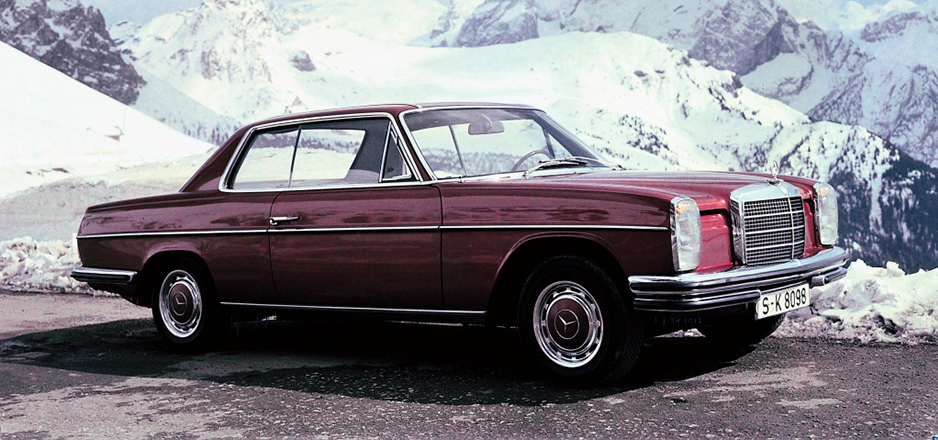
Grand backdrop: 114 series Mercedes-Benz coupé. The “Stroke 8” 115/114 model series was built from 1968 to 1976.
More space: long-wheelbase saloons
The concept of this vehicle was already familiar from the extended 200 D model of the “tailfin” generation W 110. The long-wheelbase version of the “Stroke 8” also offered seating for the driver and seven passengers in three rows. At first, this most expensive variant of the “Stroke 8”, and the one with the smallest unit volume in production (in the end output in fact added up to almost 10,000 units), was available as the 220 D and 230 models. In autumn 1973 the 240 D model extended the range.
The long-wheelbase saloon, like its predecessor, was mainly used as a taxi and hire car, as well as by travel firms, airlines, embassies and government authorities. Since sporty performance was less important in these cars than fuel economy, the percentage of diesels among the eight-seaters was very high across the entire series: slightly less than 78 percent of all long-wheelbase saloons were ordered with a compression-ignition engine – an appreciably higher rate than for the standard wheelbase saloons.
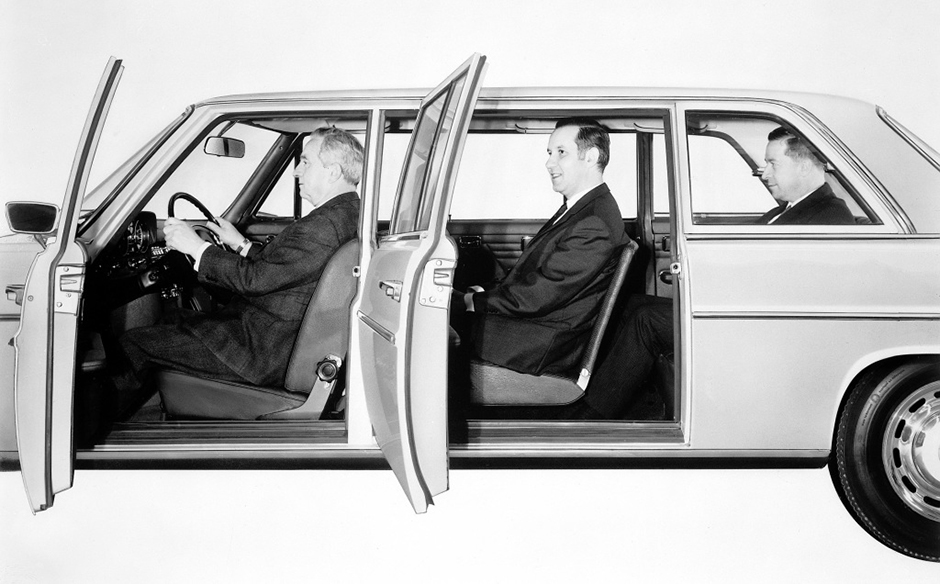
For chauffeur and seven passengers: The Mercedes-Benz 220 D and 230 models of December 1968 with long wheelbase could each seat eight people.
Chassis for bodies
In keeping with tradition, both body variants also were available as partially bodied chassis. They were fitted with special bodies by domestic and foreign bodybuilders. In particular, ambulances, fire brigade vehicles, hearses and other branch-specific special versions were produced. The ambulance bodies by Binz in Lorch and Miesen in Bonn attained a high degree of popularity.
The best-known manufacturers of hearses included the coach building firms of Pollmann in Bremen, Rappold in Walfrath, Stolle in Hanover and Welsch in Mayen. Independent bodybuilders also supplied station wagons to the customer. Initially the 220 D, 220 and 230 (short wheelbase), and 220 D and 230 (long wheelbase) were made available as a basis for conversions. Then after the facelift in autumn 1973, the 240 D, 230.4 and the six-cylinder model 230.6 were also available as chassis.
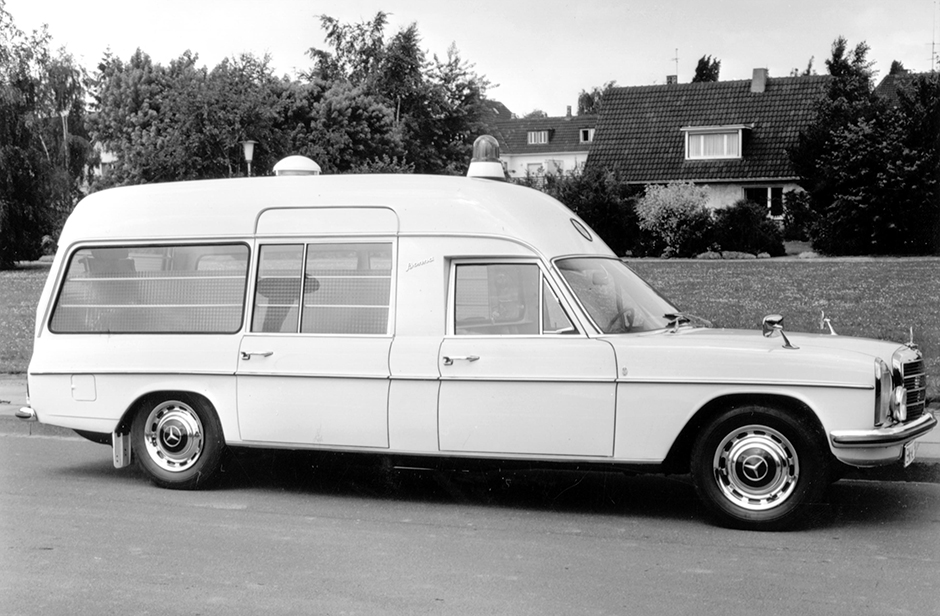
Emergency vehicle: This fast rescue vehicle from Miesen is based on a long-wheelbase chassis of the Mercedes-Benz 220 D.
New engines for the intermediate range
In April 1972 the 280 and 280 E models were added to the range. Both were available as saloon and as coupe and were powered by the newly designed 2.8-litre M 110 engine. The six-cylinder had overhead valves in a V configuration and two overhead camshafts. In the carburettor version it developed 118 kW (160 hp), and with manifold injection 136 kW (185 hp). The saloons of the new top-of-the-line “Stroke 8” models could be distinguished from the less powerful variants even without the model plate: in addition to the familiar double bumper of the 250, they had a rear bumper that wrapped right round to the wheel cut-outs, as well as two tailpipes.
On the coupe side, the 280 C model superseded the 250 CE model, production of which was discontinued. The 280 CE model with the 136 kW (185 hp) injection engine extended the performance spectrum of the series and became the new top-of-the-range model. Since the appearance of the 280 and 280 E models, the 250 was delivered to customers with the 2.8-litre power plant M 130 from the 108 and 109 series. In the “Stroke 8” the engine used was a slightly derated version, developing 96 kW (130 hp). The export version of the 250 for the USA and Canada had been coming off the assembly line equipped with this engine since July 1970.
1973: Facelift for the “Stroke 8”
Vehicle safety was the focus of an extensive facelift to which all variants of the 115 and 114 series were subjected in September 1973. Many of the new details were adopted by the engineers from the SL and SLC models of the 107 series and the current S-Class (W 116). They included, for example, flexibly mounted exterior mirrors adjustable from inside, as well as dirt-deflecting molding on the A-pillars that kept the side windows clean even in the most inclement weather, plus a rain runnel on the rear window.
Particularly conspicuous from the rear view of the car were the ribbed tail lights for minimizing dirt collection. This safety-relevant design element was to shape perceptions of Mercedes-Benz passenger cars of all classes over future vehicle generations. The four-spoke safety steering wheel from the R/C 107 and 116 series entered series production of the “Stroke 8” six months before the facelift. From March 1973 onward, head restraints and inertia-reel front seat belts then also became part of the standard equipment of the 115/114 series.
Highlights from the luxury class and new engines
The improved models were also updated visually to match the look of the S-Class in particular. The radiator grille was now lower and wider, the side windows no longer had quarterlights, the license plate panel was attached to the front bumper instead of underneath it, and the handle of the boot lid was given a different shape. As the front apron was also adapted to the design of the S-Class, the 250 through to the 280 E models together with their coupe equivalents lost their double front bumper. The only saloons of the series that continued to stand out visually from the other variants were the 280 and 280 E, since the designers left them their long rear bumper.
New four-cylinder engines were a part of the model refinements. Since autumn 1973 the OM 616 (48 kW/65 hp) in the 240 D was the top engine in the diesel model range. The 2.3-litre version of the M 115 with an output of 81 kW (110 hp) was the drive unit behind the new 230.4 model, which replaced the 220 model. The four-cylinder engine was powerful and cultivated and quickly made the vehicle a favorite. The suffix “.4” in the model designation of the new 230 became necessary, because the six-cylinder variant with the same displacement continued to be carried in the range. To make an exact distinction, Mercedes-Benz now offered this original 230 as the 230.6 model.
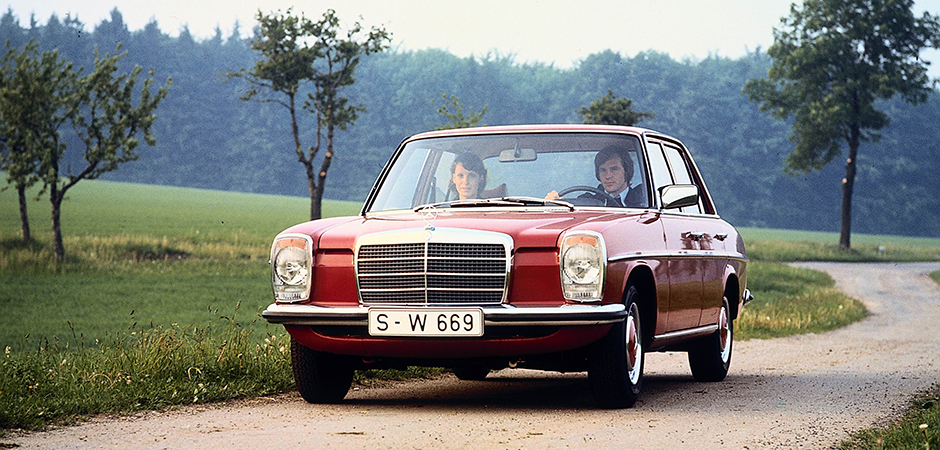
New lower and wider grille modernized the design for both the coupes and sedans in1973.
photography and text/daimler ag